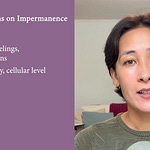Dear friends,
Over the past two weeks, we’ve been practicing close placement—focusing intentionally and narrowly on the breath. When the mind is especially busy, this technique (counting or naming the breath) gives us a strong, steady anchor that helps settle the mind and body.
As we deepen into this technique, the counting or naming begins to drop away on its own. Our mind settles and we no longer need a conceptual anchor to stay present. From here, a softer and more spacious attention emerges.
This is the second stage of shamatha, which is sometimes called ‘not too tight, not too loose.’ The phrase comes from a Buddhist parable about the Buddha and a musician (you’ll hear the story in the video, so I won’t spoil it!).
In this video, you’ll learn:
How close placement evolves into “not too tight, not too loose”
Why this next stage depends on the foundation we’ve built
The parable of the Buddha and the mandolin player
What changes in your technique, gaze, and attention
Why I found this shift kind of annoying when I first started practicing (lol)
How this stage connects with the next two in the shamatha sequence











